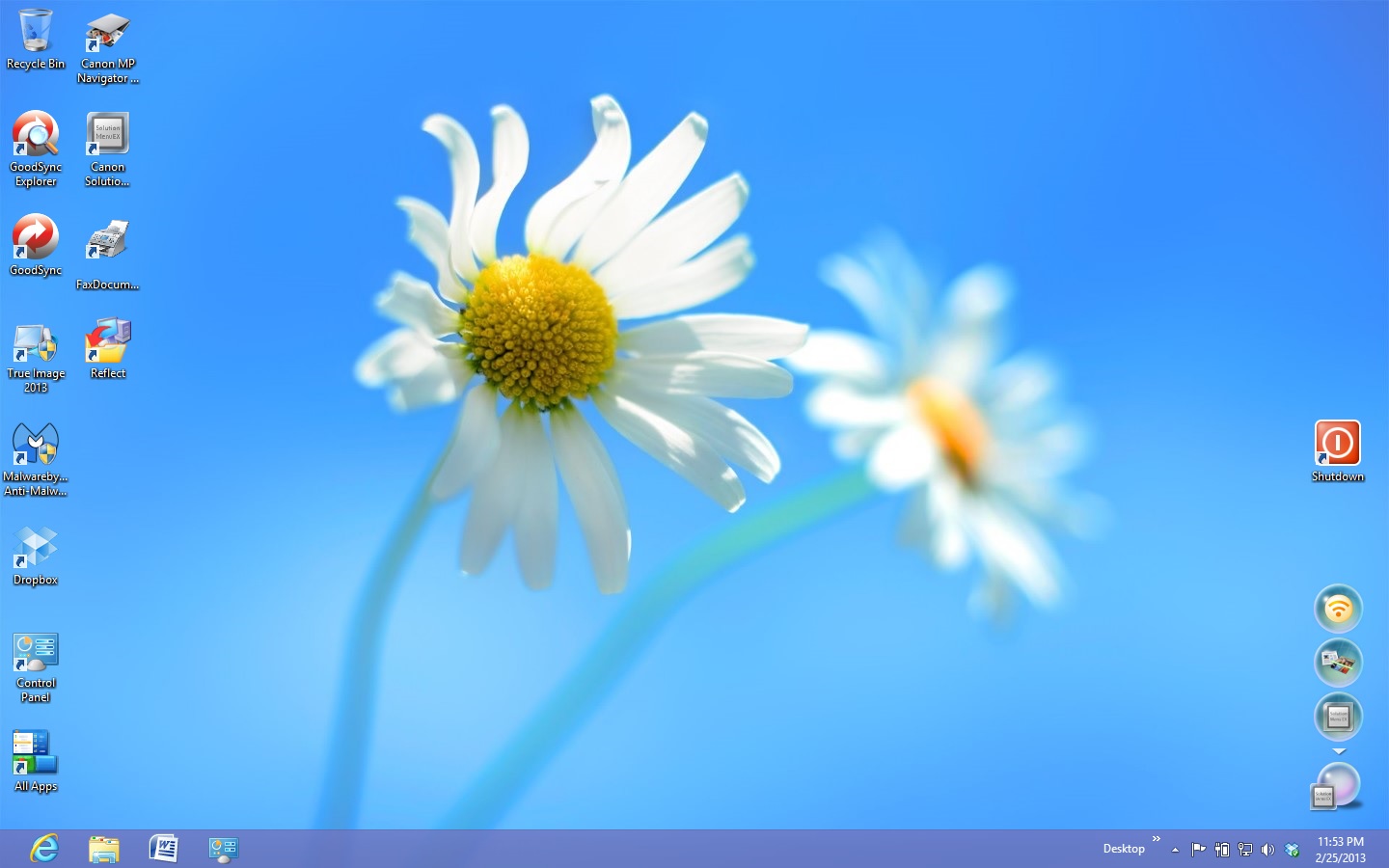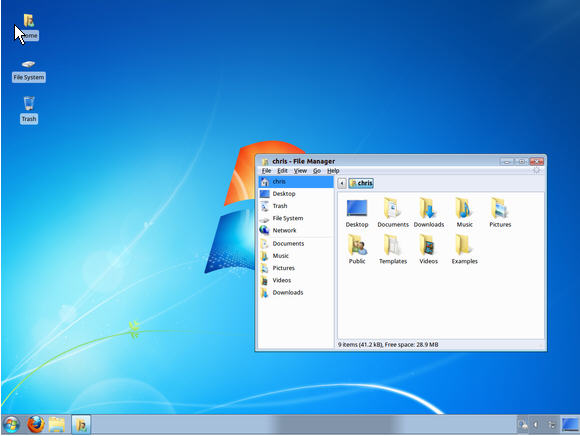
Your First Day with Windows 8
By Wayne Maruna
Microsoft introduced Windows 8 on Oct. 28th of 2012. They are allowing computer manufacturers to sell computers with their three year old but still very popular Windows 7 operating system until sometime in 2014, but a trip to the store will yield mighty slim pickings in the way of Win7 machines. So if you are a Windows person and will need a new computer in the next couple of years, you’ve got Windows 8 in your future.
As of this writing, I have installed new Win8 machines for several users and done in-place upgrades from Windows Vista on a couple others. This much is true: the Windows 8 interface is decidedly different, and there is precious little in the way of documentation to get you started. I provide my clients with a couple of pages of home-brewed documentation, and I’m going to share herein a portion of that information.

When you fire up that new Win8 machine, after a one-time start up and registration routine, you’ll most likely arrive at a screen showing an impressionist’s view of the Seattle area, with the Space Needle and Mount Rainier in the background. There are five other 'lock-screen' images that come standard with Win8; the above is the one I see the most often, so it is either the default or the one most PC manufacturers choose if they don't provide their own customized lock screen. Regardless of which image is displayed, you will see the image.....and nothing else. No start button, no directions – nada. Fear not, young Jedi, just left click your mouse and you will move past that screen. Where you go depends on whether you set up one or multiple user accounts, and whether you chose to use a sign-on password. With multiple users or a password chosen, you will be taken to a log-in screen. Enter the user name or password as required, and you will finally arrive at the Start Screen.

The Windows 8 Start Screen
You know how your current desktop has a start button and an All Programs selection? Gone! This Start Screen (SS) replaces it. The SS is made up of a series of live tiles, meaning if you click on them, they open the correspondingly named program. The tiles come in two shapes, a small square and a larger rectangle. You can right click on any tile and resize to the other shape if you wish. You can also left click and hold, and drag a tile to a different location. One of the tiles is called the Desktop tile. I always drag that one to the top left corner of the tile matrix, as that is the tile I use the most. Clicking the Desktop tile will take you to something more like what you are used to seeing, except for the lack of a Start button and menu. That tiled start screen is your new start button and all programs listing in one. Get used to it, and you have conquered the biggest hurdle in getting accustomed to using Win8.

The Windows 8 'Desktop'. Please note the Shutdown icon on the right is not standard but was created with guidance from the good folks at PCWorld Magazine
Note the absence of a Start button or 'Orb' No start menu either, Bubba.
The tiled Start Sscreen does not actually contain all of your programs, only those that someone has chosen to add to the screen. To see the whole list, right click on an open area of the Start Screen, and an icon for ‘All Apps’ will show up in the lower right corner. Click it, and you will see a listing of all the installed programs. Click any of them to open the program. Right click a program to get a choice to add it to the Start Screen. Press ESC to exit the All Apps screen.

A Partial view of an 'All Apps' screen.
Get familiar with using the Windows logo key, which is on the lower keyboard row. That key is your friend. Pressing it will bounce you from Start Screen to Desktop and back again. Used in conjunction with other keys, it serves to create ‘hot keys’ which invoke special functions. For example, holding the logo key and pressing Q will take you to the search function. Holding the logo key and pressing C will cause something called the Charms Bar to slide out from the right. (Moving your mouse to the upper or lower right screen corners does the same thing.) The Charms Bar consists of five icons for Search, Share, Start, Devices, and Settings. To power off the machine, you need to click on Settings, then on the Power Options button, and then choose Shut Down.
Even the method for closing a program is different. There is no longer a red X in the upper right corner. To close a program, you move your mouse to the top of the screen. You will see the mouse pointer change into an image of a hand. Click and drag the hand down the screen, and the program window will re-size, and when you reach the bottom of the screen, the window and program will close.
Setting up email can be a bit of a nuisance. If you have a Suddenlink or Embarq or CenturyLink email address, you are using something called POP3 email. Windows 8’s Mail app does not natively support POP3 email. (DUH!) You’ll need to search for the option of turning Windows features on and off in the Control Panel, and turn on the option for something called .NET Framework 3.5 which is not installed by default, though some PC manufacturers may choose to do so. Once it is installed, you can do a search online for Windows Live Essentials, download it, and install it, which will give you the program called Windows Live Mail. With that, you are able to set up POP3 email. If you use Gmail or Yahoo Mail or Hotmail from a web interface, you don’t need Windows Live Mail.
One of the live tiles will take you to the Store. This is Microsoft’s attempt to mimic the Apple iTunes store and generate added revenue by selling you lots and lots of $5 apps. But there is a nice selection of free apps, including Skype, Google Search, AccuWeather, DropBox, and some really terrific looking versions of Mahjongg and Solitaire. To use the Store, you will have to set up a Microsoft account. If you have a Hotmail or Windows Live account, you already have one.
There are a lot more idiosyncrasies with Win8 but space does not permit me to include more. Suffice to say that Win8 presents a challenge for anyone who is used to XP or Vista or Win7. But the more I play with it, the more appreciation I have for it.
One Person's Good Old XP Desktop, long may she wave.
BONUS QUESTION for GEEKS ONLY
(Not part of the original Taberna Tribune article)
Can you identify the operating system the following desktop screen shot comes from?

|
|
|
|
If you said Windows 7, well done. But you're wrong.
Chris Hoffman, a contributor to PCWorld, and obviously a fellow with too much time on his hands,
started with a standard Ubuntu Linux distribution with its default 'Unity' desktop, replaced Unity with something called XFCE,
and heavily modified that to mimic Windows 7. So yes, you are looking at a Linux desktop of sorts. You could live with this, yes?
Read all the gory conversion details here:
http://www.pcworld.com/article/2028896/how-to-make-ubuntu-linux-look-like-windows-7.html#tk.nl_pwr